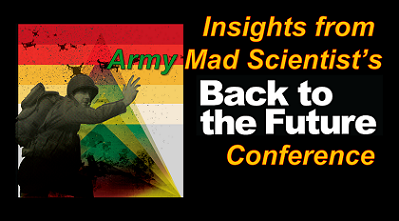[Editor’s Note: Army Mad Scientist conducted our Back to the Future Conference at the National Museum of the United States Army (NMUSA) on 8-9 November 2022. Our first post-COVID live conference featured world renowned historians, thinkers, innovators, futurists, and industry leaders who converged backcasting with futurecasting to provide penetrating insights regarding the Army’s people, materiel, readiness, and doctrine and concepts initiatives. Today’s post captures ten key insights we gleaned from their presentations and panel discussions – Enjoy!]
1. Disruptions are inevitable and the key to resilience is not avoiding them but controlling and managing when they occur. “You can’t stop the waves, but you can learn to surf by getting back on the board after getting knocked off.” Normalizing discomfort and making self-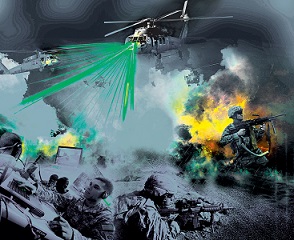 awareness the priority may help us scale training proven to enhance individual performance. Our ability to tolerate cognitive, psychological, and emotional load influences our ability to tolerate physical load, and we have to integrate cognitive fitness, psychological flexibility, and emotional agility into existing training; incorporate real performance demands; and include failure and no-win situations.
awareness the priority may help us scale training proven to enhance individual performance. Our ability to tolerate cognitive, psychological, and emotional load influences our ability to tolerate physical load, and we have to integrate cognitive fitness, psychological flexibility, and emotional agility into existing training; incorporate real performance demands; and include failure and no-win situations.
2. There are a host of technological breakthroughs converging in the multi-sensuous domain. The emerging “Internet of Everybody” will consist of synthetic sight, taste, feel, smell, and hearing — all enabled by augmented and virtual reality. This convergence could revolutionize 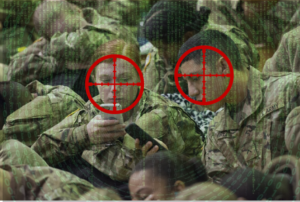 training by allowing Soldiers to “experience” the battlefield as never before. As these technologies mature and become democratized, there is also the potential for its weaponization by nefarious actors via deception, misinformation, and the broadening of attack surfaces with which to target Soldiers and their families.
training by allowing Soldiers to “experience” the battlefield as never before. As these technologies mature and become democratized, there is also the potential for its weaponization by nefarious actors via deception, misinformation, and the broadening of attack surfaces with which to target Soldiers and their families.
3. History shows us that triggering events of future crises and conflicts cannot be predicted. As former U.S. Secretary of Defense Robert Gates once said, “When it comes to predicting the nature and location of our next military engagements since Vietnam, our record has been perfect. We have never once gotten it right…”  Instilling a culture of humility to challenge our assumptions and perceptions, adaptability in the face of incorrect assumptions, and understanding of our adversaries’ priorities and perceptions may help us better understand and project future conflict.
Instilling a culture of humility to challenge our assumptions and perceptions, adaptability in the face of incorrect assumptions, and understanding of our adversaries’ priorities and perceptions may help us better understand and project future conflict.
4. Everyone can think like a futurist. To foster innovation, one must continually challenge orthodoxy and question processes. Be plausible  but provocative with a rich imagination, and — above all else — maintain an insatiable curiosity. An environment that engages diverse thinkers, but stays true to organizational goals, will allow us to prepare for — rather than predict — future uncertainty.
but provocative with a rich imagination, and — above all else — maintain an insatiable curiosity. An environment that engages diverse thinkers, but stays true to organizational goals, will allow us to prepare for — rather than predict — future uncertainty.
5. Synthetic biology is the next general purpose technology. Like electricity, and more recently, the internet, SynBio has the potential to fundamentally change society. From altering human DNA to creating new forms of viruses to converging bio and cyber attacks, we may not be ready for what’s to come.  The U.S. should be leading in this space, but, as with artificial intelligence, we are late to the game. This involves a different kind of competition and conflict, which we may not be preparing for.
The U.S. should be leading in this space, but, as with artificial intelligence, we are late to the game. This involves a different kind of competition and conflict, which we may not be preparing for.
6. The Army is missing out on small businesses. While there are mechanisms in place to work with small businesses, these are often not adequate to address the pace and malleability in which these businesses  work. In these cases, small businesses cannot survive waiting six months to a year for the Government to implement a contract vehicle. This can lead to both sides missing out on opportunities to grow and achieve much needed solutions to national security problems. The Army has an opportunity to embrace small businesses and recognize the value and quick-win solutions they can offer.
work. In these cases, small businesses cannot survive waiting six months to a year for the Government to implement a contract vehicle. This can lead to both sides missing out on opportunities to grow and achieve much needed solutions to national security problems. The Army has an opportunity to embrace small businesses and recognize the value and quick-win solutions they can offer.
7. Psychohistory. Just as historians study history by finding evidence and drawing conclusions, so too can futurists when trying to project possible futures. Projecting these futures, or scenarios, allows us to use  evidenced-based analysis to describe complex adaptive systems. This, in turn, allows us to better prepare for the wide range of outcomes that the future might produce and avoid detrimental or devastating surprise. By studying the patterns, systems, and behaviors of the past, we can better understand complexity and uncertainty. The most important question we can ask about the future is, “What if?”
evidenced-based analysis to describe complex adaptive systems. This, in turn, allows us to better prepare for the wide range of outcomes that the future might produce and avoid detrimental or devastating surprise. By studying the patterns, systems, and behaviors of the past, we can better understand complexity and uncertainty. The most important question we can ask about the future is, “What if?”
8. The right person, for the right job, at the right time. Rather than trying to predict what skills and abilities we’ll need in the future and then adapting personnel, it’s even more important to gather data on the 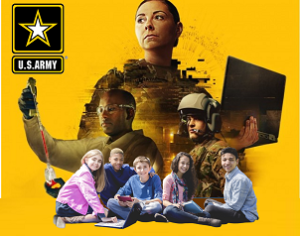 personnel we have now, across multiple different factors. The key piece is expanding how we assess and characterize people and figuring out where to integrate new capabilities into what is assessed. Determining who our lifelong learners are, looking at knowledge, skills, and abilities / behaviors, assessing motivation, and moving away from cohort-based management will help us get the right person for the right job at the right time.
personnel we have now, across multiple different factors. The key piece is expanding how we assess and characterize people and figuring out where to integrate new capabilities into what is assessed. Determining who our lifelong learners are, looking at knowledge, skills, and abilities / behaviors, assessing motivation, and moving away from cohort-based management will help us get the right person for the right job at the right time.
9. Concept writers and technology developers need to work hand in hand. Innovation and progress will be bolstered by a careful balance between pushing the limit conceptually and ensuring technology can be 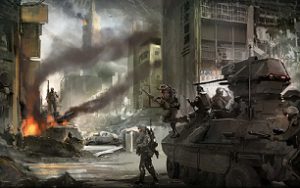 feasibly designed, developed, and delivered. Futuring can inform technology developers about the art of the possible, as well as help guide concept writers to better envision and understand the future possibilities associated with the Operational Environment. We have the ability to design and shape the future we want.
feasibly designed, developed, and delivered. Futuring can inform technology developers about the art of the possible, as well as help guide concept writers to better envision and understand the future possibilities associated with the Operational Environment. We have the ability to design and shape the future we want.
10. Experiment with ideas and don’t settle for easy answers. Doctrine writers need only look back to the post-Vietnam era for a successful model of critical thought and intellectual conversations. 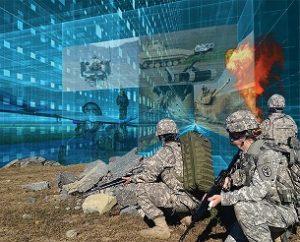 Taking warfighters’ experience and judgement and applying it to unfamiliar, unanticipated situations will help us develop doctrine that aims to impose greater costs on our adversaries than on ourselves; but we must be willing to use “innovation” and “adaptation” as more than just buzzwords.
Taking warfighters’ experience and judgement and applying it to unfamiliar, unanticipated situations will help us develop doctrine that aims to impose greater costs on our adversaries than on ourselves; but we must be willing to use “innovation” and “adaptation” as more than just buzzwords.
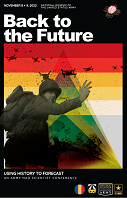 If you enjoyed this post, check out the content from this conference (including the agenda, presenter and panelist biographies, and presentations) here.
If you enjoyed this post, check out the content from this conference (including the agenda, presenter and panelist biographies, and presentations) here.
… as well as the following related content:
Imagining the Future Fight through Emerging Technology and associated podcast, with proclaimed Mad Scientist Jenny McArdle, Cmdr. Paul Grøstad, and Whitney McNamara
The Exploitation of our Biases through Improved Technology, by Raechel Melling
Making the Future More Personal: The Oft-Forgotten Human Driver in Future’s Analysis and “Once More unto The Breach Dear Friends”: From English Longbows to Azerbaijani Drones, Army Modernization STILL Means More than Materiel , by Ian Sullivan
The Case for Restructuring the Department of Defense to Fight in the 21st Century, by LTC Christopher J. Heatherly
Forging the Future to Find the Next Great Disruptor and associated podcast, with proclaimed Mad Scientist Amy Webb
Designer Genes: Made in China? by proclaimed Mad Scientist Dr. James Giordano and Joseph DeFranco
Crossing the Valley of Death for Innovation and associated podcast, with Trish Martinelli and David Schiff
Ultimate Victory: Lessons on Future Warfare from Field-Marshal Viscount William Slim, by Luke Shabro
Recruiting the All-Volunteer Force of the Future and The Inexorable Role of Demographics, by proclaimed Mad Scientist Caroline Duckworth; and U.S. Demographics, 2020-2028: Serving Generations and Service Propensity
The Future of Talent and Soldiers and associated podcast, with MAJ Delaney Brown, CPT Jay Long, and 1LT Richard Kuzma
The Operational Environment (2021-2030): Great Power Competition, Crisis, and Conflict, along with its source document
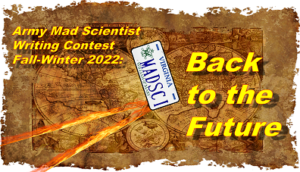 Back to the Future Writing Contest: Crowdsourcing is an effective tool for harvesting ideas, thoughts, and concepts from a wide variety of interested individuals, helping to diversify thought and challenge conventional assumptions. Army Mad Scientist seeks to crowdsource the intellect of the Nation (i.e., you — our community of action!) with our Back to the Future Writing Contest. Entries should address one of the suggested topics listed here. Entries will be accepted in two formats:
Back to the Future Writing Contest: Crowdsourcing is an effective tool for harvesting ideas, thoughts, and concepts from a wide variety of interested individuals, helping to diversify thought and challenge conventional assumptions. Army Mad Scientist seeks to crowdsource the intellect of the Nation (i.e., you — our community of action!) with our Back to the Future Writing Contest. Entries should address one of the suggested topics listed here. Entries will be accepted in two formats:
-
-
- A written essay (no more than 1500 words, please!)
-
-
-
- A tweet @ArmyMadSci using #MadSciBacktotheFuture
-
We will pick a winner from each of these two formats! Contest Winners will be proclaimed official Mad Scientists and be featured here in the Mad Scientist Laboratory. Semi-finalists of merit will also be published!
This contest is open to any and every one — multiple submissions are encouraged!
DEADLINE: All entries are due NLT 11:59 pm Eastern on January 13, 2023!
Questions? Send us an eMail at: madscitradoc@gmail.com
Disclaimer: The views expressed in this blog post do not necessarily reflect those of the U.S. Department of Defense, Department of the Army, Army Futures Command (AFC), or Training and Doctrine Command (TRADOC).

